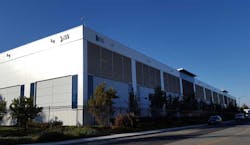The largest Internet companies continued to lease lots of data center space in 2015, leading to one of the strongest years yet for providers of wholesale server space, according a new report from a leading data center real estate specialist.
The robust activity demonstrates that the growth of cloud computing is providing a huge boost for data center developers. While many analysts predicted that cloud providers would compete with commercial data center operators, they have instead become their largest customers.
There’s little doubt that cloud business models will eventually impact the market for on-premises data center space, especially smaller server closets. But for now it is clearly boosting demand for “plug-n-play”data center halls.
“Cloud leasing has not adversely affected wholesale leasing,” said Jim Kerrigan, Managing Director of North American Data Center, which tracks wholesale inventory across the U.S. “In fact, it has contributed to making 2015 one of the best leasing years ever.”
Microsoft, Apple, LinkedIn and Uber all signed multiple deals in major data center markets in 2015, according to North American Data Centers’ Year in Review report (PDF). Wholesale activity in 2015 kept pace with record leasing in 2014, which in turn was up 37 percent from 2013 levels.
Major Markets Stay Busy
The biggest markets did best in 2015, as there was vibrant leasing in northern Virginia, Silicon Valley and the greater Chicago markets.
“Santa Clara (California) had its best leasing year since 2011, and will have limited supply in 2016,” said Kerrigan. The report cited a long list of companies leasing significant (2 megawatts or more) footprints in the Santa Clara market, including Microsoft, Amazon, Uber, Alibaba, Arista Networks, SoftLayer, VMWare and Symantec. Santa Clara is the leading data center hub in the Silicon Valley market because its local utility, Silicon Valley Power, has elecrticity rates that are slightly lower than surrounding towns served by PG&E.[clickToTweet tweet=”Jim Kerrigan: Demand from cloud builders made 2015 one of the best data center leasing years ever. ” quote=”Jim Kerrigan: Demand from cloud builders made 2015 one of the best data center leasing years ever. “]
It was also a red-hot year in northern Virginia, with most of the wholesale leasing activity focused on Loudoun County’s highly-connected “Data Center Alley” in Ashburn. DuPont Fabros Technology (DFT) leased more than 25 megawatts of capacity in northern Virginia in October alone, and Digital Realty also had several large leases.”Virginia will continue to do well, with some recently-built space and new multi-tenant data centers to be announced,” said Kerrigan.
Most of the action in Chicago was in the suburban market, where Digital Realty and DFT each signed multiple large leases in newly-built data center buildings.
Microsoft Continues Building Big
Microsoft continues to expand its data center capacity on a scale that suggests a great deal of confidence about coming growth. As it seeks to expand its infrastructure to support its shift to the a cloud-driven business model, Microsoft is pursuing a hybrid strategy we first noted in 2013, in which it builds state-of-the-art data centers in areas where land and power are cheap, and leases third-party wholesale space in key markets where it is expensive to build and operate large server farms.
According to North American Data Centers, in 2015 Microsoft signed three large wholesale deals, in several cases filling space vacated by other tenants:
- A lease in Ashburn for 10 megawatts in a DuPont Fabros Technology (DFT) building recently vacated by Yahoo.
- A deal in Santa Clara, California with Vantage Data Centers in a building vacated by a previous tenant. Vantage’s V2 building was built and fully-leased in 2012 with a design featuring elements of the Open Compute Project hyperscale design. Vantage announced the availability of V2 in October, but said Friday that it was breaking ground on a new building, clearly suggesting that V2 had been successfully leased.
- New space in a Digital Realty campus in Franklin Park, Illinois where it will serve as an anchor tenant.
The largest lease of the year, according to North American Data Centers, was a 12 megawatt deal for Juniper Networks to take space in a Sabey Data Centers facility in Quincy, Washington, a data center hub known for its affordable hydro-electric power and ideal environment for using fresh air to cool server halls.
Cloud Leads to Boom, Not Bust
In the wholesale data center model, a tenant leases a finished suite of “turn-key” raised-floor space. The other primary third-party data center model is colocation, in which tenants buy smaller amounts of space by the cabinet or cage. Cloud computing offered an alternative: the ability to run applications within virtual machines hosted on a public platform like Amazon WebS ervices, with no need to house hardware in a third-party facility.
In our recent Executive Roundtable, data center executives agreed with Kerrigan’s contention that cloud is helping multi-tenant data center providers, rather than hurting them.
“Some analysts will say that cloud computing is the biggest risk to the colocation market,” said Jim Leach, Vice President of Marketing at RagingWire Data Centers. “In fact, the opposite is true. Cloud computing providers are some of the biggest and best customers for colocation companies.”
“Several years ago, people were predicting that cloud computing would cannibalize the colocation data center market, and they were completely wrong,” said Rob McClary of FORTRUST. “Cloud computing service providers are a new and growing customer vertical, which has accelerated growth in many multi-tenant colocation data centers.”
About the Author



